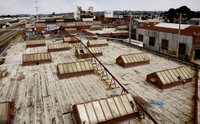Report from the ongoing “Underbelly Tours” of Richmond





Update from Shannon: - Photos by Dashal Moore
As the director of Touchable Stories I’ve been exploring the often unseen places or underbelly of Richmond through a series of guided tours of the many neighborhoods. From cops to cowboys, my designated tour-guides have all shown me unique perspectives of this place adding an incredibly rich dimension to the ongoing exploration and discovery of Richmond.
On Wednesday, Dashal Moore (UCB Grad. Ethnic Studies) and I were treated to a tour of a former roofing factory, just over the tracks on Chesley St. in North Richmond by Ellen Gailing – The City of Richmond’s “Photo Girl”. Protected by combat boots, with Ellen and Dashal both toting digital cameras we entered one building after another in this huge complex of structures that has been abandoned for who knows how long. Graffiti, temporary sleeping structures, and random machinery left over from the manufacture of roofing supplies, existed in one variation or another everywhere we went. The majority of graffiti was exceptional – being a former painter I have a soft spot for anyone who can successfully get a spray paint can to do painterly things. Ellen identified the main artists as the “Lords” who have chapters throughout California and apparently even have their own website. We arrived late morning on Ellen’s advice to give the sleeping folks time to get up and off to start a brand new day. Ellen and Dashal shot so many images that by the end of the afternoon and multiple flash cards later, both were experiencing a distinct twitch in the right eye and some blurring of vision. Both though, had a well defined grin that lasted all the way home.
I found myself playing detective and trying to piece together how the factory was set up, the function of the machines left behind, and a general gathering of the remaining pieces of evidence that could put the machine back in motion in my head. Most people we encountered thought we were reporters or maybe OSHA inspectors even though none of us were sporting a clipboard.
Today a city employee will be giving us a tour of the 3rd floor of the old city hall – at 2pm - right after his union meeting he tells me. We have been searching for a “centrally located” site in Richmond for our final exhibit and this place was on our list. Believe it or not – no one is at home there – city hall moved closer to coast 3 or 4 years ago and are renting facilities there because the civic center needs an overall refit for earthquakes that still has yet to happen.
The underbelly tours will be a continuing series as Ellen and other Richmond folks have promised more surprise adventures to come. Our next tour scheduled will be led by Donald Hardison, currently a board member of The Richmond Museum of History but also the architect responsible for many buildings in Richmond including the original Easter Hill Housing project, JFK & Richmond High, and the Hall of Justice in Richmond’s Civic Center. So keep posted.
- Shannon Flattery
Artistic Dir/Founder Touchable Stories
Artist-in-Residence UCB Art Research Center




